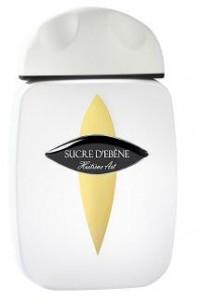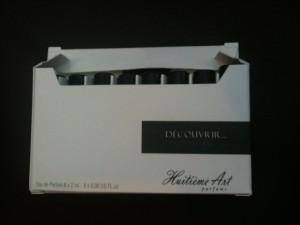Previously on Ca Fleure Bon’s series on Huitieme Art Parfums:
Michelyn Camen interviewed Pierre Guillaume about his new line of fragrance Huitieme Art Parfums.
And now the conclusion as I review the remaining four; Ambre Ceruleen, Naiviris, Fareb, and Sucre d’Ebene.
Ambre Ceruleen
Ambre Ceruleen is the only one of the eight fragrances in the Huitieme Art Parfums line that was less than interesting. The four notes in it are Opoponax, Tonka bean, Sandalwood and the phyto-perfumery extract of Organic Moroccan Verbena. This is the one case where the three more traditional ingredients crowd out the new extract. Ambre Ceruleen is powerfully about the opoponax and tonka to start, with the sandalwood upping the wattage. It is no surprise that the more introverted verbena got buried underneath the onslaught. Very late in the development, after the extroverts have tired themselves out, the verbena begins to speak up but after listening to the stronger voices it causes it to lose its impact. Of all of the fragrances in the line this is the one I most wish M. Guillaume had a “do-over” on. I really would like to experience the verbena in a composition where it isn’t turned into a wallflower.
Naiviris
Of all of the fragrances in the Huitieme Art Parfums line Naiviris was the one I was looking forward to most from an unsniffed perspective. M. Guillaume has shown a deft touch when it comes to the use of iris. The two iris fragrances for Parfumerie Generale, Cuir d’Iris and Iris Taizo, along with the iris fragrance M. Guillaume created for Laboratorio Olfattivo, Daimiris. Naiviris is more in line with the construction of Iris Taizo as Naiviris is also a combination of wood and iris. As with all of the other Huitieme Art Parfums the construction is kept two-note simple but the exotic aspect of the two notes used makes for something special. The wood component is zebrawood and the iris is the extract of African Red Orris (Kigelia Africana). The iris comes alive right from the get-go and it has a piquant spicy aspect to it most closely resembling the clove-like aspect one finds in carnation. The spicy feel in the Red Orris is not as heavy as what you find in carnation it instead floats with a nose-tickling come hither feel reminiscent of pink pepper to me. The zebrawood is very similar to wenge wood and it provides the woody harmony to allow both of the new phyto-perfumery accords the opportunity to truly flower to their fullest potential.
FAREB
The name comes for the initials, in French, of what M. Guillaume was attempting here; “Fraiche, Aromatique, Resineaux, Epice et Boise” (Fresh, Aromatic, Resinous, Spicy and Woody for the non-French speaking readers). FAREB is an example of phyto-perfumery at its best as the two new extracts in use here are Bois d’Immortelle and Ginseng. That these two notes achieve all five of the adjectives in FAREB’s initials is a testament to what can be accomplished with this new extraction method. FAREB evokes a bit of the feel of walking into an Indian spice market as there feels like a bare hint of curry along with the ginseng. The Bois d’Immortelle adds a woody quality with a leather accord. I’m not sure if it is both notes together or one in particular that also adds a strong crushed mineral quality to FAREB but it reminds me a bit of the crushed marble accord from Kenzo UFO with less polish and more grit to it. FAREB is the most nuanced of the Huitieme Art Parfums and it is that sense of much more going on than only two notes should be able to provide that make FAREB my co-favorite of the line with Manguier Metisse.
Sucre d’Ebene
For the last fragrance in the Huitieme Art Parfums line, Sucre D’Ebene, M. Guillaume decided to finish with a sweet resinous flourish. Brown sugar and benzoin are the two traditional notes that sandwich the phyto-perfumery extract of witch hazel. Many of us are probably familiar with the sweetly astringent odor of witch hazel as it is used by many people as toner for their skin or as an anti-bacterial on cuts and scrapes. In Sucre D’Ebene it is used as the connective tissue between the sweet brown sugar and the resinous benzoin. That witch hazel has the duality to enhance and reflect sweet and resinous is no surprise to anyone who has used it cosmetically. The surprise is that it provides a strong presence of its own and instead of feeling like I was smelling my medicine cabinet the witch hazel became something much more. The longer Sucre D’Ebene stayed on my skin the more I realized the witch hazel wasn’t the connective note. Instead it was the central note and in the latter stages of development it is the brown sugar and benzoin which retreat leaving the witch hazel alone in the spotlight like a newly discovered ingénue.
All of the Huitieme Art Parfums have excellent longevity and average sillage.
As I stated in Part 1 these opening fragrances using the new phyto-perfumery extracts feel like sketches. Even the best of them, Manguier Metisse and FAREB, while completely enjoyable could have been made incredible by having some traditional top notes added to prepare the fragrant palate for the unusual olfactory repast to come. Even so I do believe that M. Guillaume intended to keep these first creations simple so we could absorb the difference in the nature of the notes created by the new technology without distraction. On that level all, but Ambre Ceruleen, succeed brilliantly. I am already eagerly awaiting what M. Guillaume, and others, will create with these new fragrant colors on their perfumer’s palette.
Disclosure: This review was based on preview samples provided by Huitieme Art Parfums.
Now a lucky Ca Fleure Bon reader will also get to discover the “Huitième Art Parfums" line. Thanks To Pierre, we are giving away The Decouvrir Kit, which contains a 2ml spray of each fragrance. We will draw from among all comments on this article, the interview by Michelyn Camen and Part 1 of the reviews. The draw will take place on Wednesday October 6 at 11:59 PM EST.
You must leave a comment on Cafleurebon.com to be eligible.
-Mark Behnke, Managing Editor








